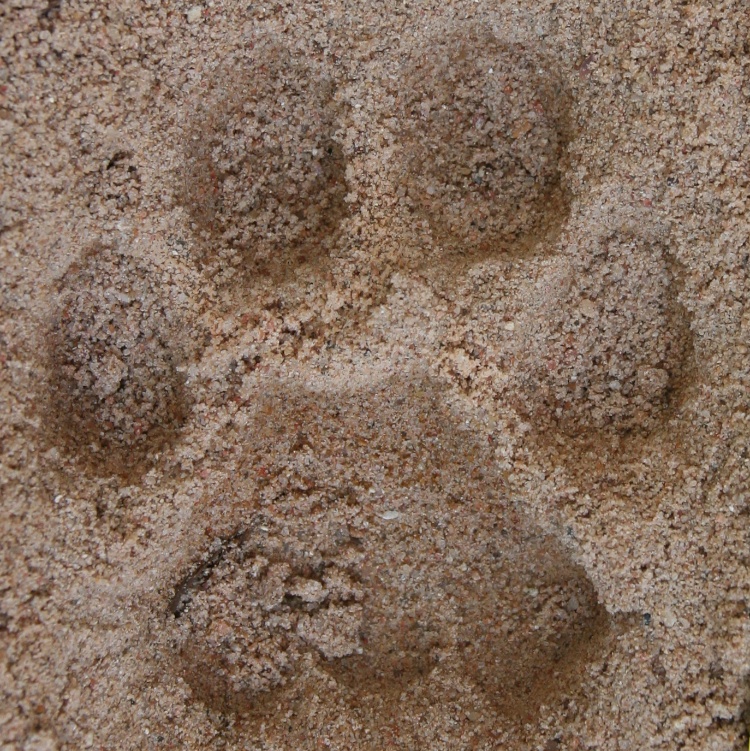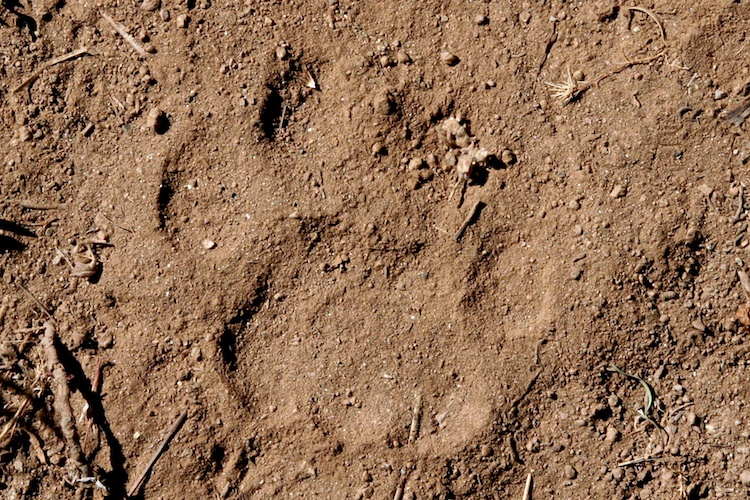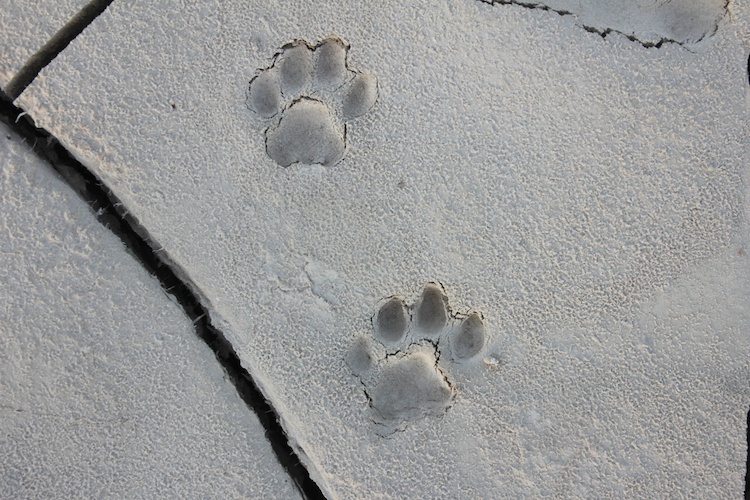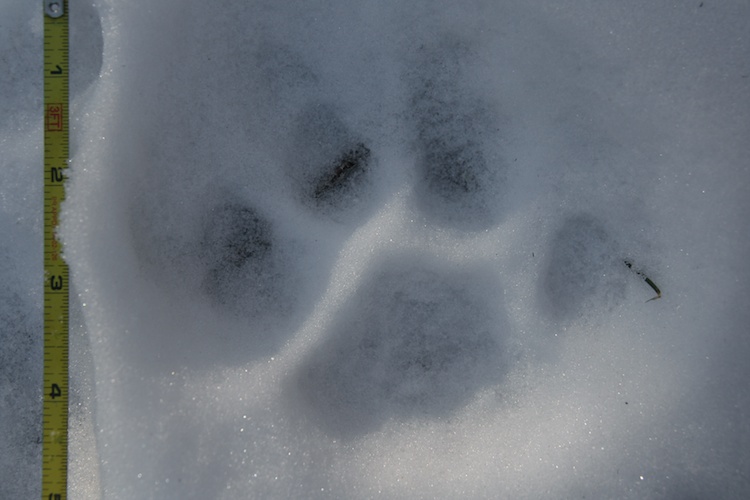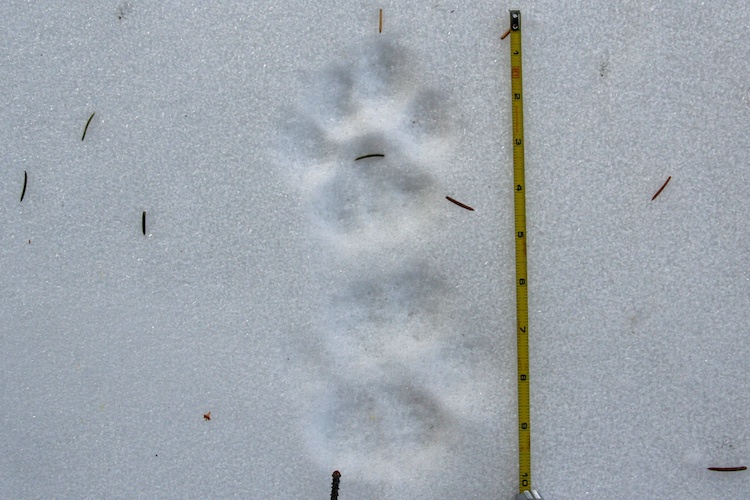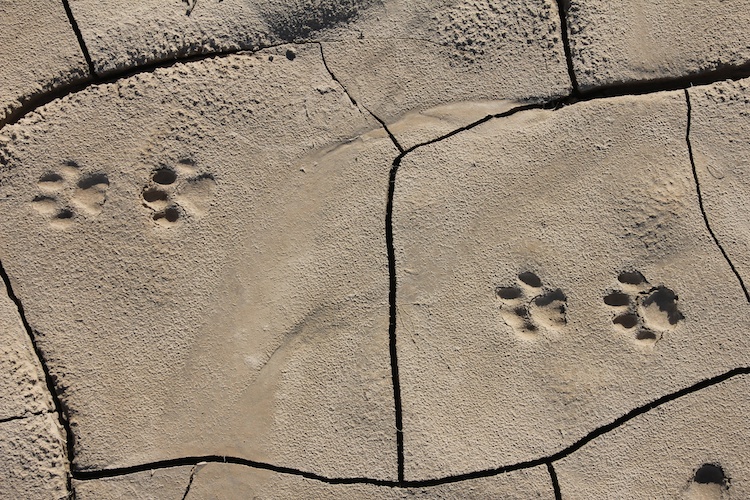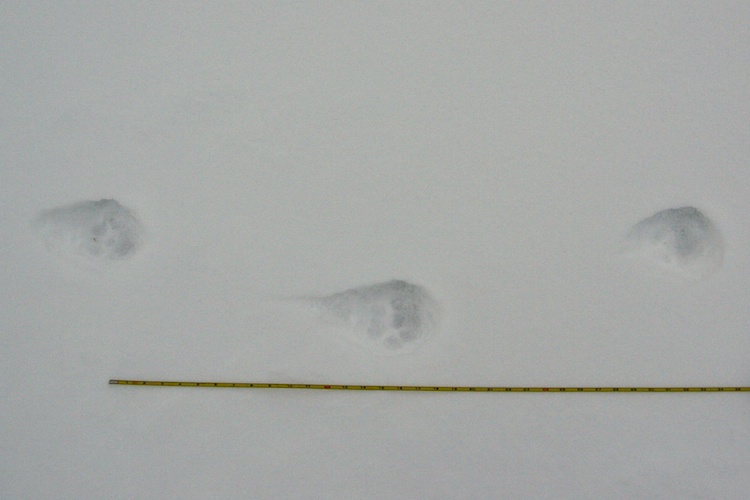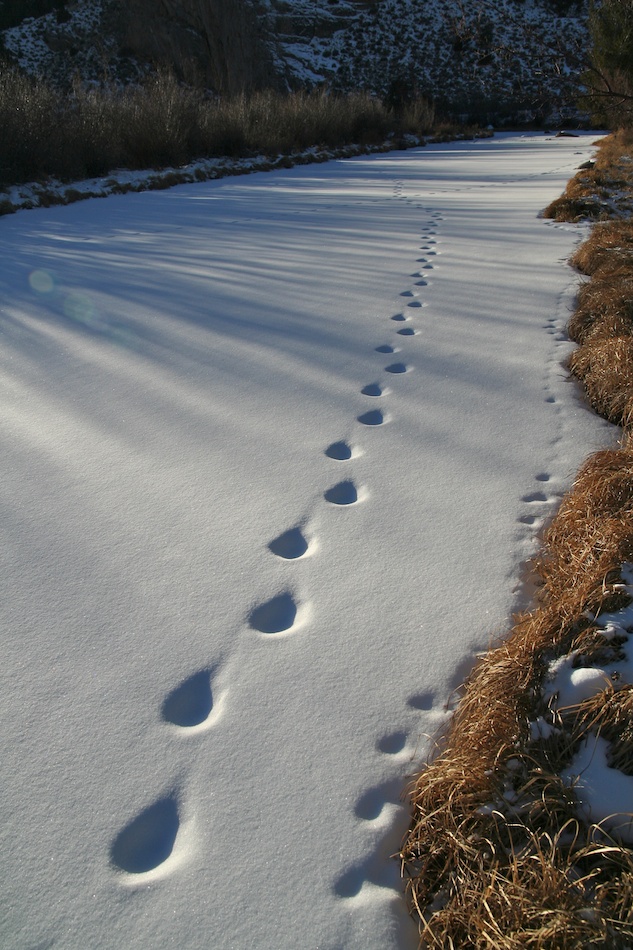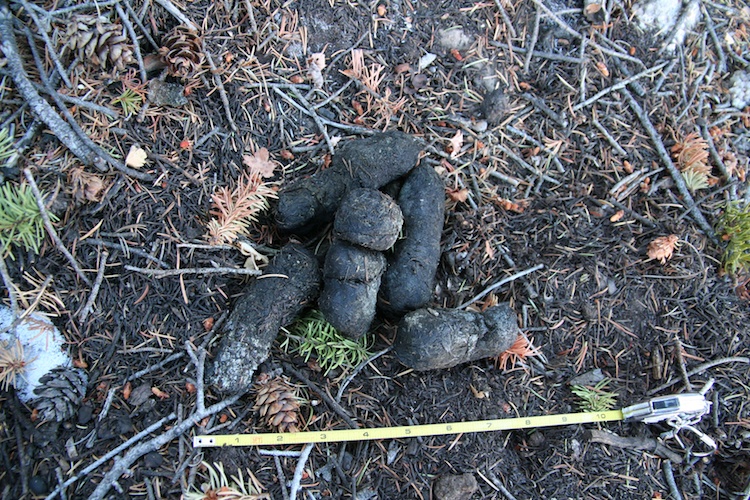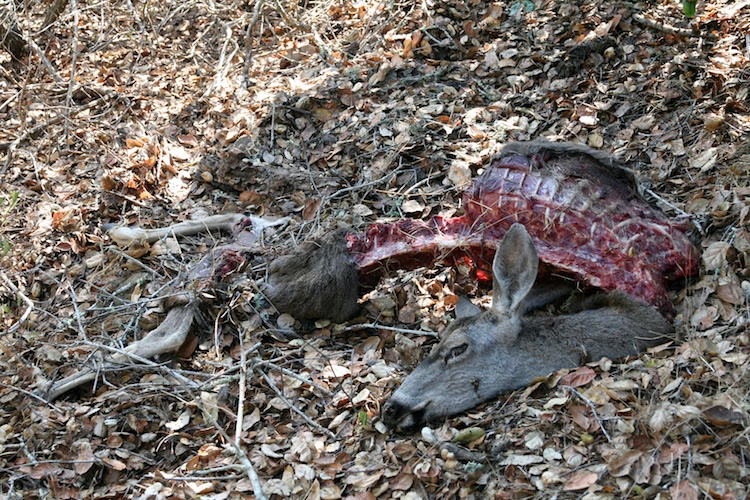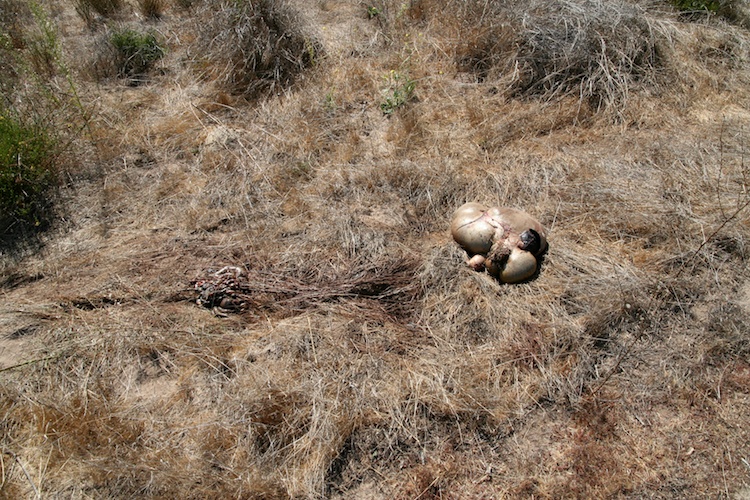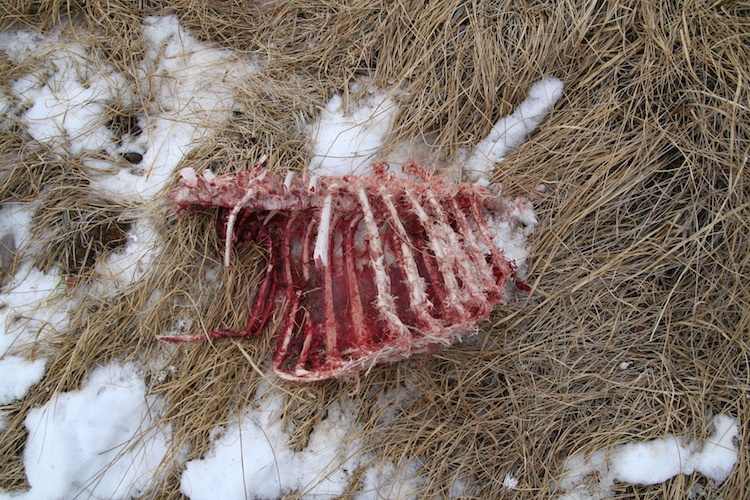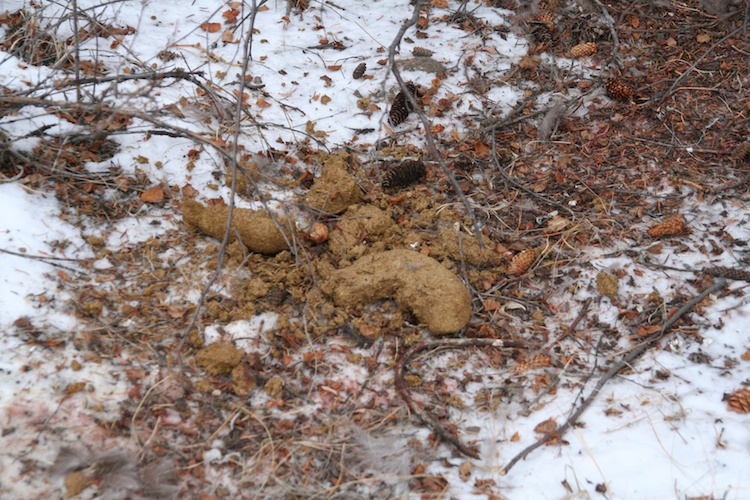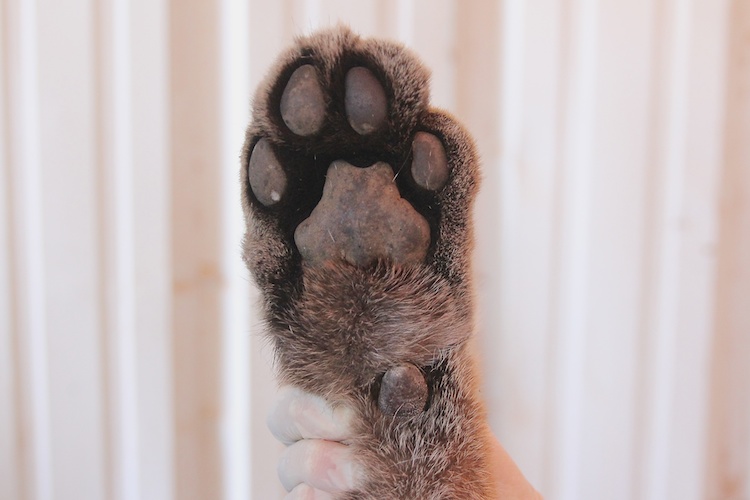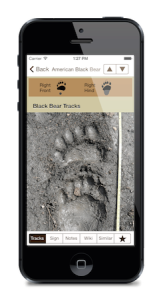Mountain Lion Right Front Track
- 2.2 – 4.2 in (5.7 – 10.5 cm) long.
- 1.6 – 4.3 in (4.1 – 10.9 cm) wide.
- 4 round toes show in the track. The inside toe (toe 1) is higher up the leg and does not usually register.
- Sharp, retractable claws rarely show.
- The track is asymmetrical. Toe 3 is the longest and is useful for determining side of body. Track is flat with toes and palm pad registering about the same depth.
- Palm pad is trapezoidal with 2 lobes at the anterior end. Palm pad is proportionately larger than in canine tracks, usually about the size of 4 toe pads.
- Front track is wider and more asymmetrical than the hind track.

Mountain Lion Right Hind Track
- 2 – 4.2 in (5.1 – 10.6 cm) long.
- 2.5 – 4.8 in (6.5 – 12.1 cm) wide.
- 4 round toes show in the track. Toe 1 is absent.
- Sharp, retractable claws rarely show.
- The track is more symmetrical than that of the front foot, though it is still somewhat asymmetrical with toe 3 longer than the rest. Track is flat with toes and palm pad registering about the same depth.
- Palm pad is trapezoidal with 2 lobes at the anterior end. Palm pad is proportionately larger than in canine tracks.
- Hind track is narrower and more oval-shaped than the front track.

Mountain Lion Tracks
A left hind track of a mountain lion. Mountain lion front and hind tracks show 4 toes and a large palm pad. Also note the asymmetry and the double lobe at the anterior end of the palm pad. Hind tracks are more symmetrical than front tracks.
A left front (on right) and left hind mountain lion track. Note that the front track is wider and more asymmetrical than the hind track.
The right front track of a mountain lion in dust. Note the strong asymmetry and large pad. Mountain lions tend to flick their front feet when walking which usually slightly obscures their front tracks.
Note that the mountain lion hind tracks are more narrow and symmetrical than the fronts. This is a right hind track.
While some lion tracks show prominent lobes at the posterior end of the palm pad, this feature is not diagnostic. Some dog tracks also show this trait.
The large track on the right is a splayed mountain lion track. Note the bi-lobed palm pad and asymmetry. Claw marks are visible, but they are sharp and do not register very deeply. Also, note the bobcat tracks on the left and the raccoon tracks in the middle.
A left front (below) and left hind mountain lion track. Note that the front track is wider and more asymmetrical than the hind track.
A mountain lion traveling from right to left in an overstep walk. The tracks from right to left are: LF, LH, RF, & RH.
The zigzag walking trail of a mountain lion in snow. Traveling from left to right. Mountain lions often prefer to direct-register walk in snow.
Mountain Lion Scat
Cougar scat is similar to that of other cats: it usually contains only meat and fur, it has blunt ends and a segmented appearance, and it is very dense.
Mountain Lion Sign
The carcass of a mule deer killed by a mountain lion in California. Canine marks were clearly visible on the neck and the lower ribs were broken off.
The rumen and other intestines from the same kill as the preceding photo. These were found about 50 yards from the carcass. Mountain lions frequently remove the intestines to make it easier to drag off to a safer place to feed.
The rib cage of a mule deer killed by a mountain lion in Wyoming. Note how the lower ribs are broken to enable easier access to the internal organ.
Mountain lions (especially males) frequently make scrapes using their hind feet. These scrapes may contain a spray of urine, but not always. It is thought that these scrapes serve some kind of scent marking purpose.
The left front foot of a female mountain lion. This mountain lion was hit by a car in west Texas. Note the small heel pad higher up on the leg.
The following images are the recent mountain lion track and sign observations from the North American Animal Tracks Database. This is an iNaturalist project where trackers share observations and help each other learn about animal tracks, all while contributing to scientific research. Identifications of tracks on this page are initially made by members of the public and may not be correct. The tracks will eventually be verified by experts.
Mountain Lion
Size: About 3-4” long x 3-5” wide (front and hind foot measurements combined).
Metacarpal pad: The metacarpal pad in cougar tracks is trapezoidal shaped and fills a large portion of the track. The pad is usually as large as all 4 toes combined. The anterior portion of the pad is wide and may be flat or bi-lobed (often described as a letter “m” shape). Three lobes are usually visible in the posterior portion of the pad.
Symmetry: The toes of cougar front feet are asymmetrically arranged around the pad, with toe 3 (your middle finger) longer than the rest (the thumb does not register). Front feet tend to be wider and more asymmetrical than the hind feet. The hind feet of pumas can be very symmetrical and may leave tracks that more closely resemble those of canines.
Claws: Claws occasionally register in cougar tracks, but they are sharp and thin when compared to the large blunt claw marks in dog tracks.
Domestic Dog
Size: Not useful. Large dog tracks can easily surpass the largest cougar tracks.
Metacarpal pad: The metacarpal pad in dog tracks is triangular shaped and fills a much smaller portion of the overall track than in cougar tracks. The pad is usually about the size of 3 toes or smaller. This is one of the most useful characteristics for differentiating cougars from dogs. Two or three lobes may be visible in the posterior portion of the pad.
Symmetry: Dog tracks are usually symmetrical. However, asymmetrical dog tracks happen on occasion. The asymmetry found in dog tracks is usually to a much lesser degree than what is found in cougar prints. As in cougar tracks, the front feet of dogs are wider and more likely to be asymmetrical than the hind feet.
Claws: Dog tracks usually have large blunt claws. However, the lack of claws is NOT a reliable indicator for identification. Many dog tracks will not register claw marks.
There are many great guides to identifying animal tracks. While a few are truly excellent, there are others with surprising inaccuracies. The guides below are my absolute favorites and won’t lead you astray. If you decide to purchase any of these guides, using the links below will help support future developments to this website.
iTrack Wildlife is my own guide to animal tracks for the iPhone and Android. It has over 700 high resolution photos of tracks, scats, sign, and skulls. It also has over 120 accurate track drawings for 66 mammals. What makes this app really different from other guides to animal tracks is the search tools that let you quickly narrow down a track by size, the number of toes, the shape of the toes, track symmetry, the mammal group, and the state or province.
Mammal Tracks and Sign of North America by Mark Elbroch is the modern bible of animal track and sign identification. Its publication drastically changed the field of animal tracking and spawned a renewal of interest in the field. It has hundreds of color photos and precise track drawings. The book is organized by the type of sign (tracks, scats, chews, digs, etc) making it easy to identify sign, but not great if you want to read about all the details of a single species. Also, the comprehensive nature of this book makes it an amazing resource, but it can be quite a load in your backpack. If you don’t own this book and you’re serious about tracking, you should definitely get it.
Animal Tracks and Scat of California is a regional guide, but many of the species are found throughout North America. This guide includes mammals, birds, and even some reptiles, amphibians, and invertebrates. It is a great general tracking guide (full disclaimer: I am a co-author of this guide) and is a great bet if you want a single guide that covers more than just mammals. This book also has some helpful sections not found in Bird Tracks and Sign including a quick reference to life-sized bird tracks.
Wildlife of the Pacific Northwest is a regional guide written by my friend and excellent tracker David Moskowitz. While the book primarily focuses on the Northwest, much of the information applies nationwide. This tracking guide includes mammals, birds, reptiles, amphibians, and invertebrates. The guide also contains excellent original artwork and beautiful photography. This guide is truly worth adding to your library.
The Peterson Guide to Animal Tracks is the classic tracking guide. This book was published in 1954 and inspired many trackers and naturalists. It was a major work for an author at the time with so few other resources available and predictably it contained several small errors. In 2005 is was updated by Mark Elbroch who made corrections, added information, and many photos.
Tracking and the Art of Seeing by Paul Rezendes was the first animal tracks guide in North America to contain color photographs. This guide drastically changed the landscape of future tracking guides. For example, just about every single subsequent field guide uses a similar stipple-point style for drawing tracks. This guide is more of a desk reference and is great reading. It is organized by species, so it is great for learning about an animal, but difficult to use to identify a particular type of sign.
A Field Guide to Mammal Tracking in North America by Jim Halfpenny is a classic guide that led to many advances in animal tracking. While the guide doesn’t contain color photos of tracks, there is a valuable scientific approach to identifying tracks that has very practical applications. He also covered gaits and animal movements in the most comprehensive manner at the time. While there are newer guides with perhaps more accurate information available, this guide made them possible.
The Animal Tracks: Midwest Edition by Jonathan Poppele is a book that surprised me. I expected this guide to be just another low quality pocket guide. However, what I found was anything but low quality. It has fantastic track drawings, accurate information, and a very handy organization method. This book is inexpensive and worth adding to your library.
Looking for More?
Sign Up to Get News, Updates, and Tracking Tips by Email.




